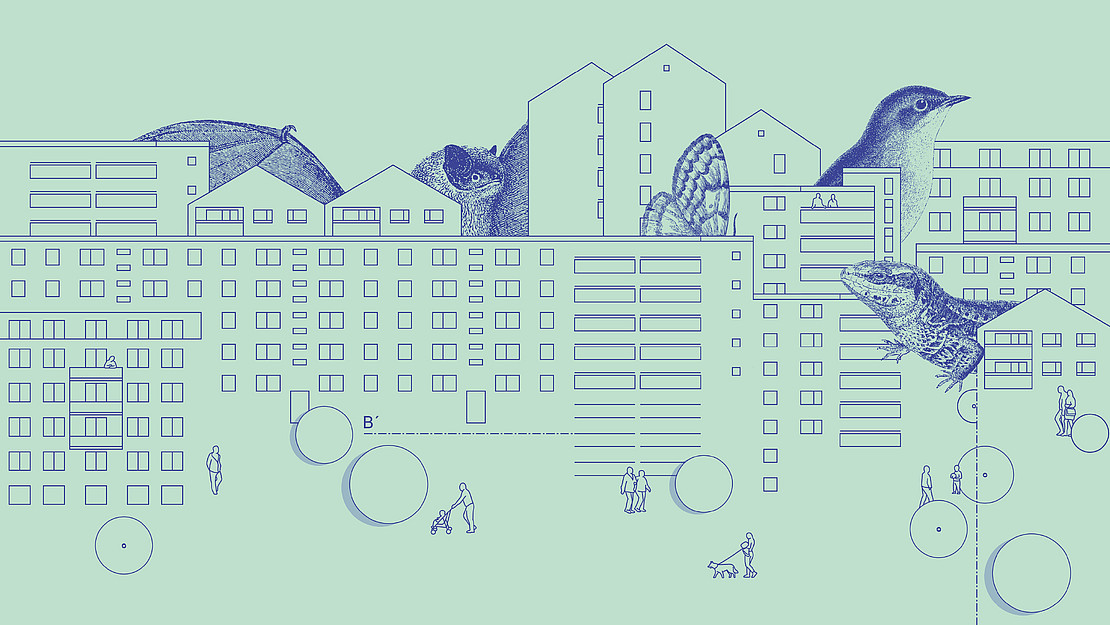This page contains automatically translated content.
Door to door with sparrow and hedgehog
 Image: Sophie Jahnke.
Image: Sophie Jahnke."The keyword is animal-aided design, or AAD for short," says landscape architect Dr. Thomas E. Hauck. He is responsible for research and teaching at the University of Kassel's Department of Open Space Planning. "At its core, animal-aided design is about viewing animals not as annoying guests, but as equal users of urban nature," says Prof. Dr. Wolfgang Weisser, Professor of Terrestrial Ecology at TUM, who is involved in the new research field together with Thomas Hauck.
In a scientific project, Hauck and Weisser have examined for which species and in which phases of planning an application of AAD in the city can be promising. "The important thing is: urban planning under the seal of AAD must incorporate the life cycle of the animals, otherwise it won't work. A nest box is of no use to the sparrow if it can't find food nearby to raise its young, the hedgehog needs a lawn to forage for earthworms, the admiral needs cavities to hibernate," Weisser makes clear.
Many housing companies do take nature conservation seriously, even if there are still some reservations: "Some see problems with soiling facades, for example," says Weisser. "And for some, there are also fears about the transmission of diseases," adds Hauck. However, many of these problems can be solved, he says: "For example, the swallow can be given a nesting aid with a board to collect dirt so that the facade does not become dirty," says Hauck.
To test the feasibility of animal-aided design in practice, the two scientists examined ten real projects of housing companies throughout Germany.
"Municipal and private housing companies, which are responsible for much of the built space in the city, were open to AAD in our survey, which combines attractive building with the creation of nature that can be experienced," says Hauck, summarizing the results. Some are now even implementing the plans. The scientists present their findings in the new publication "Animal-Aided Design in the Residential Environment," which is freely available for download online.
Together with his colleague Hauck, he now wants to continue working on making humans and animals equal co-inhabitants in cities.
Background
The German Federal Agency for Nature Conservation (BfN) funded the research project (preliminary investigation for a development and testing project) "Animal-Aided Design (AAD) - Incorporating the Needs of Animal Species into the Planning and Design of Open Spaces" as a cooperative project of the University of Kassel and the Technical University of Munich with funds from the German Federal Ministry for the Environment, Nature Conservation and Nuclear Safety (BMU) for a period of 3 years. The interdisciplinary research project was led by landscape architect Dr. Thomas E. Hauck (University of Kassel, Department of Open Space Planning) and biologist Wolfgang W. Weisser (Technical University of Munich, Chair of Terrestrial Ecology).
Download the publication: https://www.bfn.de/fileadmin/BfN/planung/siedlung/Dokumente/AAD_Broschuere.pdf
Contact:
Dr.-Ing. Thomas E. Hauck
University of Kassel
Department of Open Space Planning
Gottschalkstraße 26
Tel.: 0561 804 - 2484
E-mail: thomas.hauck[at]asl.uni-kassel[dot]de
Prof. Dr. Wolfgang W. Weisser
Technical University of Munich
Chair of Terrestrial Ecology
Hans-Carl-von-Carlowitz-Platz 2
Tel: 08161 71 - 3495
E-Mail: wolfgang.weisser[at]tum[dot]de
& nbsp;